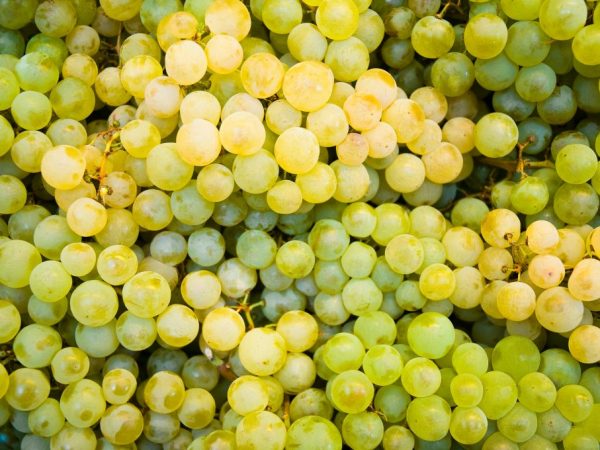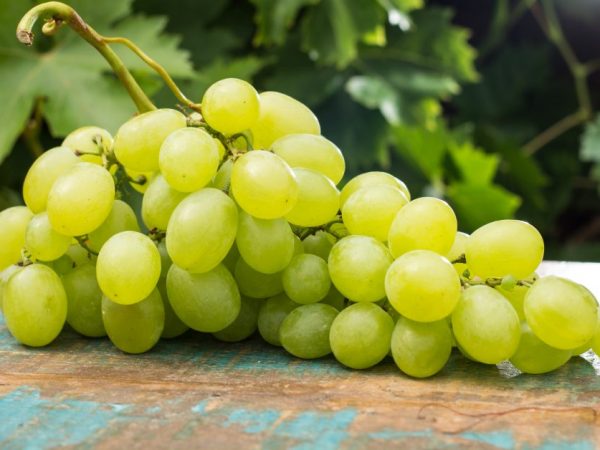The main properties of White raisins
Some of the varieties of grape culture came to us from the countries of the East and Asia. One of these is the White Kishmish grape. It is a dessert variety with juicy pulp and small seeds.

The main properties of White raisins
Characteristics of grapes
It is impossible to find White raisins in natural conditions. The lack of seeds prevents the variety from multiplying on its own. The variety appeared as a result of mutations in other species.
Bush characteristic
The white raisin grape is one of the strongest in the world. She is long and tall. Maximum load - over 70 eyes.
The bush has hermaphrodite flowers. According to the description, 5 stamens of each inflorescence are equal in length to the pistils.
Fruit characteristics
Bunches of White Kishmish grapes reach medium size, however, there are also large clusters with several branches. The shape of the bunches is cylindrical, with tight-fitting berries. The upper part is split in two.
The berries themselves are small. Their shape is oval, slightly elongated. Fruit color ranges from lemon to amber yellow. Occasionally, there are points of dark shades on the fruits. The pulp is covered with a translucent skin that breaks easily. From above, the skin is covered with a layer of natural wax. Caloric content is 40 kcal per 100 g of product.
Disadvantages of the variety
Despite the lack of seeds and the pleasant taste of the fruit, the White Kishmish variety has a number of disadvantages:
- low level of productivity;
- high vulnerability to diseases and pests;
- fragility of berries;
- poor transportability;
- poor preservation.
Grapes of this type are used for the preparation of dried fruits. Much less often White Kishmish is used for making juice or wine.
Beneficial features
The berries of white raisins contain vitamins of groups A, C, E, PP. The presence of a large amount of minerals and acids of organic origin was also noted.
The consumption of this type of grape crop benefits the body:
- prevents the progress of pathological processes affecting the kidneys and liver;
- promotes the treatment of respiratory diseases;
- has a diuretic and choleretic effect;
- helps in the fight against nausea and heartburn;
- prevents the formation of ulcers and blood clots;
- reduces the risk of developing osteoporosis;
- has a calming effect on the body, helps relieve stress.
Iron is also present in grape juice. This substance contributes to the pectin production process. This component helps to establish digestive processes, providing an antioxidant effect on the body.

Berries are good for the body
However, the benefits of consuming berries are not available to all people. There are a number of contraindications to eating the Kishmish culture of the White variety. This product is prohibited for people with diabetes, pancreatitis, cholecystitis and stomach ulcers.
Due to the content of acids in the composition of the grapes of this varietal variety, it has a detrimental effect on the state of the tooth enamel. The product must not be used together with dairy and fermented milk products.
Cultivation of culture
In order to grow a good and healthy White Kishmish on the site, it is important to follow agricultural techniques. A properly planted seedling that is properly cared for will yield a bountiful harvest.
Features of planting seedlings
Planting of young seedlings of this grape variety can be carried out in autumn and spring. Both spring and fall planting are popular with gardeners.
The autumn planting of white raisins is good because the break between digging up a young vine and placing it in the soil is minimal. This can significantly reduce the risk of plant death during winter storage. However, harsh winters can also defeat a fragile and poorly rooted sprout.
It is better to plant grapes in autumn in October or at a later date. It is important to do this before frost. The seedling is protected from frost with a plastic cover. It is also buried in peat or coniferous paws.
Spring planting is carried out when stable warm weather is established, and night frosts are no longer a threat to young shoots. This season, the vines are planted from April 20 to May 20.
How to choose the right landing site
Grapes are a crop that needs a lot of light and warmth. It is planted in places open to the sun.
Bad neighbors for culture are structures located on the west or east side. If there are any, during the day, the vine will receive an insufficient amount of sunlight, which will negatively affect the ripening of the fruits.

Grapes love sunshine
You should also avoid being near trees. The powerful root system of the tree will inhibit the development of the grape root, which will lead to the death of the seedling.
The root system of grapes goes deep into the depths. For this reason, a landing site is chosen in which the groundwater is not too close to the surface. Otherwise, a retraction is made. Plant contact with groundwater leads to decay and subsequent death.
Grapes are a crop that prefers to grow in clean soil. This is the reason why you shouldn't plant your vine near cesspools or fireplaces. Also, the landing should be fenced from the road to avoid contact with a large amount of dust.
Landing algorithm
If the gardener wants to get a healthy vine as a result, the following sequence of actions is used when planting:
- Dig holes 0.7 x 0.4 x 0.8 m (depth, width, length).
- At the bottom of each hole, lay a layer of ash mixed with superphosphate.
- Lay a layer of drainage material: crushed stone, gravel, expanded clay.
- Place a layer of potting soil consisting of fertile soil, sand and humus.
- On the southern side of the hole, install a pipe about 1 m long and at least 5 cm in diameter.
- Strengthen the pipe with gravel, cover with soil and compact well.
- To the north of the pipe, make a small hill of fertile land.
- Place a vine seedling in the center of the embankment, tilting it south of the pipe.
- Fill up the hole.
With this method of planting, according to the description, the sprouts will be watered directly from the installed pipes. This arrangement of the elements allows moisture to reach the root system without problems.
Basic rules of care
Correct care of the White Kishmish crop is no less important than planting in the soil. It is possible to get a bountiful harvest only with painstaking cultivation of vines in compliance with agricultural technology.
Watering mulching and loosening
White Kishmish, like any other type of this culture, requires at least 30 liters of liquid per week. The pause between soil moisture should not exceed 4 days.
Watering is stopped 2-3 weeks before and during harvesting.At this stage, you only need to slightly moisten the soil by spraying.
Mulching allows you to reduce the time spent on loosening and weeding the area. It is important for the procedure to use a proven, specially processed material.
Fertilizer
Top dressing is carried out before flowering. The most suitable period is the formation of the first 3 leaves. When fertilizing, it is important to exercise caution and a sense of proportion. An excess of nutrients has a retarding effect on the growth and development of the vine.
In the spring, nitrogen fertilizers are used. In the future, complex mineral and potash fertilizers, as well as wood ash are introduced into the soil.
Conclusion
The consumption of raisins berries brings many benefits to the body, and proper cultivation of bushes allows you to regularly harvest and feel the beneficial effects of the culture on yourself from year to year, enjoying white juicy fruits with low calorie content.


